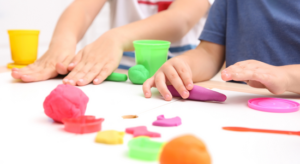Nowadays, especially in our post-COVID restrictions world, kids are spending more and more time on computers or tablets. They are watching videos, playing games, and even typing homework at a younger age. This is impacting the emphasis on handwriting and having a mature grasp. Many children are struggling to learn the proper pencil grasp to use and the proper way to write and form letters. There are a few tips we can give in order to improve children’s grasp on writing utensils!

1. Play-Dough and Putty
The first thing we address in occupational therapy when it comes to handwriting is hand strength, is your child able to hold a writing utensil for more than a few seconds without fatiguing? When they get tired and don’t know how to express that, it can look like resistance to the activity. Playing with play-dough or putty in a variety of ways can improve hand strength.
Have your child build, roll, smash, push, and pinch the play-dough. You can also hide things like small beads in the play-dough and have your child search and find them like a treasure hunt! Play-dough mats are a great reusable item to create a space for child to be creative. Print out a picture of a pizza and have your child make the toppings out of play-dough or print a blank face and have your child create the facial features with play-dough! They can be as silly as they want!

2. Tweezers/Tongs Games and Clothespins
Handwriting used small muscles in the hand that are hard to strengthen or address. One way we can do this is by playing games or activities that use tweezers or tongs. Operation is a great one for older children! For little children you can use your regular tweezers or there are types on Amazon or other websites that are larger and plastic, easier for smaller hands.
Your child can sort colored items, transfer pompoms, or even pick up small pieces of food. Similarly to tweezers, you can use clothespins to strengthen small hand muscles. Having your child clip them to various things throughout the house or using them to match colors or letters are great ways to use clothespins for children!

3. Use Tiny Utensils for Tiny Hands
One thing people assume when they have small children is that they need to use larger writing utensils when beginning to color or write. We give child large markers, large dry erase markers, large crayons, etc. assuming that will be easier for them to hold. While it is easier for children to hold large writing utensils it does not encourage them to use a proper mature grasp. It is more challenging for tiny hands to manipulate their fingers on larger utensils.
What we like to encourage in occupational therapy is using smaller utensils to encourage more finger use. We typically use skinny markers for coloring and dry erase, golf pencils that are shorter, and we often break our crayons so they are half as long. When using broken crayons children cannot hold the entire crayon in their hand and are forced to use their fingers more. The crayons work while you don’t have to. Just don’t let your little ones see you break their crayons!

4. Stringing Beads
Another great way to help your children developing the small muscles in their hand as well as improve their visual motor skills and bilateral coordination is to string small beads onto string. This is a great activity to work on with little ones because it also does not seem like work, it can be fun! You can encourage your kids to make necklaces, bracelets, and more with you!
Using small beads forces kids to use a pincer grasp without even noticing, this grasp will help build the small muscles they need to hold a pencil for a longer period of time. For really little children you can begin with larger beads then transition to small ones once they are more comfortable with the large beads. You can also work on sequencing and organizing patterns, skills required for handwriting, by stringing a pattern and asking your child to copy it!
These tips can help encourage your child to build a strong and mature dynamic tripod pencil grasp to help them be as successful with their handwriting as they can be! If your child isn’t quite writing yet, check out our blog on teaching pre-writing strokes!
Written by Jenny Zapinski, MSOT, OTR/L

